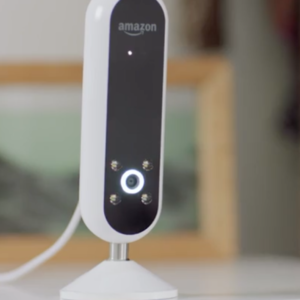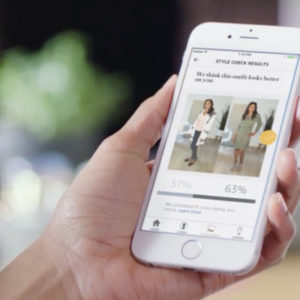
Author: Richard Yao


Updates On Boundless Retail: From Omni-Channel To Customer-Centric
In this first entry of our “Updates on Boundless Retail” series, we take a closer look at Amazon’s and Walmart’s recent acquisitions, how they are becoming more alike than ever in terms of the shopping experience they provide, and why a customer-centric approach is what will define the next stage of Boundless Retail.
On June 16, the retail world was shaken up by two major acquisitions. Amazon announced its $13.7 billion acquisition of Whole Foods while Walmart announced it is buying premium menswear brand Bonobos for $141 million. For us, these two announcements offer a rather intriguing juxtaposition to re-examine the current state of retail and the way an emerging convergence of online/offline retail channels is shaping the sector’s future.
On one side, the Whole Foods acquisition solidifies Amazon’s entry into brick-and-mortar retail, as the deal bought Amazon “431 upper-income, prime-location distribution nodes” that will further boost its logistical prowess, particularly in the food and grocery categories. On the other, Walmart, the biggest physical retailer in the world, is buying a fashion retailer that uses its physical stores strictly as showrooms and sells everything through its website. As a result, both companies are racing against each other to become more like each other, as they blur the line between physical and online retail.
In our 2016 Outlook trend report,we observed:
“As ecommerce, physical, and on-demand retail become tightly integrated, our smartphones are becoming our passports, connecting our online preferences, profiles, and activities to our offline shopping experiences, and vice versa. Boundless Retail allows consumers continuous access to sellers who build relationships through multiple touchpoints and channels.”
Now, halfway into 2017, it is becoming clear that the concept of Boundless Retail is evolving into an even more seamless and customer-centric stage. The omni-channel approach that most traditional brick-and-mortar retailers have started to adopt is certainly helpful in meeting the increasing demand in ecommerce. However, it lacks the fluidity that exemplifies the reality of shopping today, where the customer journey no longer follows through one particular sales channel but rather would jump between various channels as they wish. For instance, they may discover your product on a social channel during commute, order it on a desktop device when they are at work later, and then decide to pick up the item in store on their way home. Or they may discover your product when they are window shopping and later decide to make an impulse purchase on their mobile device.
This kind of random and mutable shopper behavior enabled by the abundance of retail channels renders the previous channel-defined strategies no longer efficient, since the siloed way of thinking prevents retailers from truly embracing a customer-centric approach that prioritizes consistently optimized customer experience over driving customers down particular sales channels. Amazon and Walmart, as the biggest retailers in ecommerce and brick-and-mortar respectively, understand this new retail reality. On a closer look at these two acquisitions, it is clear that both companies are actively implementing a more seamless shopping experience that is not so much as omni-channel but rather channel-agnostic.
Amazon has been trying to get into the grocery business for a couple of years now, first with private-label food products sold on Amazon.com and later with AmazonFresh slowly rolling out to select markets. In fact, one could say that Amazon has been eyeing the grocery market since 2012 with the acquisition of Kiva system, which span out from Webvan, the first ever on-demand grocery platform. Buying Whole Foods instantly gives Amazon access to the premium grocery customers they have been chasing after and, more importantly, the mass scale it needs to make the grocery business operational as a modularized service.
As analyst Ben Thompson pointed out in his Stratechery post, buying Whole Foods sets up the infrastructure that Amazon would need to launch Amazon Grocery Service, where the ecommerce behemoth would leverage its distribution scale to take over the perishable goods market and disrupt all food-related businesses. Amazon chose to commoditize its cloud platform and made Amazon Web Services (AWS) a white-label product that all businesses can use and build upon, which ended up dominating the web service market with it unparalleled scale and cloud computing power. Now it is aiming to do the same with perishable goods.
Amazon could care less if a rival online retailer wants to host their website on Amazon Web Services, as it will only feed into their cloud business. (Walmart, understandably, aims to undermine Amazon by ordering its vendors to use AWS competitors instead.) Similarly, the perishable goods that Amazon holds under its grocery operations now gain a high-volume brick-and-mortar channel, and vendors could care less about whether their products are being sold via Amazon Fresh or Whole Foods stores. Buying Whole Foods provides Amazon with a guaranteed, large-volume customer of the perishable goods in its network so as to justify scaling up its wholesale grocery operations and better compete with other grocery retailers.
Make no mistake, Amazon still has a long way to go in its quest to conquer offline grocery business the way they did with their cloud service. At the moment, Walmart still controls the biggest share of the U.S. food and grocery market (about 14.5%), followed by Kroger (7.2%), according to estimates by GlobalData Retail. In comparison, Whole Foods currently sits a 1.2% market share and Amazon with a 0.2% share. But with Whole Foods now under its control, Amazon can start pushing for a grocery shopping experience for its Prime members that is totally fluid and channel-agnostic, using the Prime account as the cross-channel identification key, and convert more grocery shoppers into its ecosystem with the combined appeal of Whole Food’s high-end brand and an optimized shopping experience.
Of course, Walmart is not going down without a fight. The decision to acquire Bonobo’s shows the supermarket chain is determined to work towards building a more fluid, customer-centric shopping experience. Already, the company has been steadily rolling out curbside grocery pickup services in select U.S. markets. Last month, it took that concept one step further with a trial run of automated pickup grocery pickup kiosks at an Oklahoma City store.
The sustained success of Bonobo’s unique ecommerce-led, showroom-supporting strategy will provide Walmart with some much-needed insights into how to develop a flexible online/offline shopping experience to take on Amazon’s advances in online apparels, evidenced by the new fashion-minded Echo Look and Prime Wardrobe service, which brings the “try-before-you-buy” model to Prime shoppers. It will be fascinating over the next few years to watch the two retail giants battle it out over grocery and fashion retail.
So, given the current state of the retail market and the way its future is shaping up to be, what’s a U.S. retailer whose name is neither Amazon nor Walmart to do? Well, the first step is to recognize the fact that there is no way you will be able to compete with those two behemoths in terms of scale. Amazon has pretty much dominated ecommerce traffic and will continue to buy its way into the brick-and-mortar market, whereas Walmart will still have the largest physical retail store count in the world as it continues to grow and improve its ecommerce operations. There is simply no viable way to compete with their massive scale and the operational advantages that come with it.
That being said, retailers can still carve out a sustainable and profitable business by focusing on differentiation and perfecting the shopping experience they provide. As Andy Dunn, CEO of Bonobo’s, astutely pointed out, retailers need to focus on developing a unique brand identity with proprietary differentiation points that will offer customers a good reason, be it low cost, exclusive selections, personalized recommendations, or a unique shopping experience, to choose you over their default retail choices. As the kind of purposeful shopping, where the shoppers already know what they want to buy, becomes increasingly expedited and even automated by digital tools, the experience is becoming the ultimate differentiation point that retailers need to focus on.
Not every retailer can afford to be omni-channel, but every one can find a way to make their products, services, customer experience, and ultimately your brand, different enough to attract a loyal customer base. In the next stage of Boundless Retail, the end goal is not simply to be present on every sales channel, but to build a retail brand that is so distinguished and beloved by your customers that it won’t matter which channel you are on.
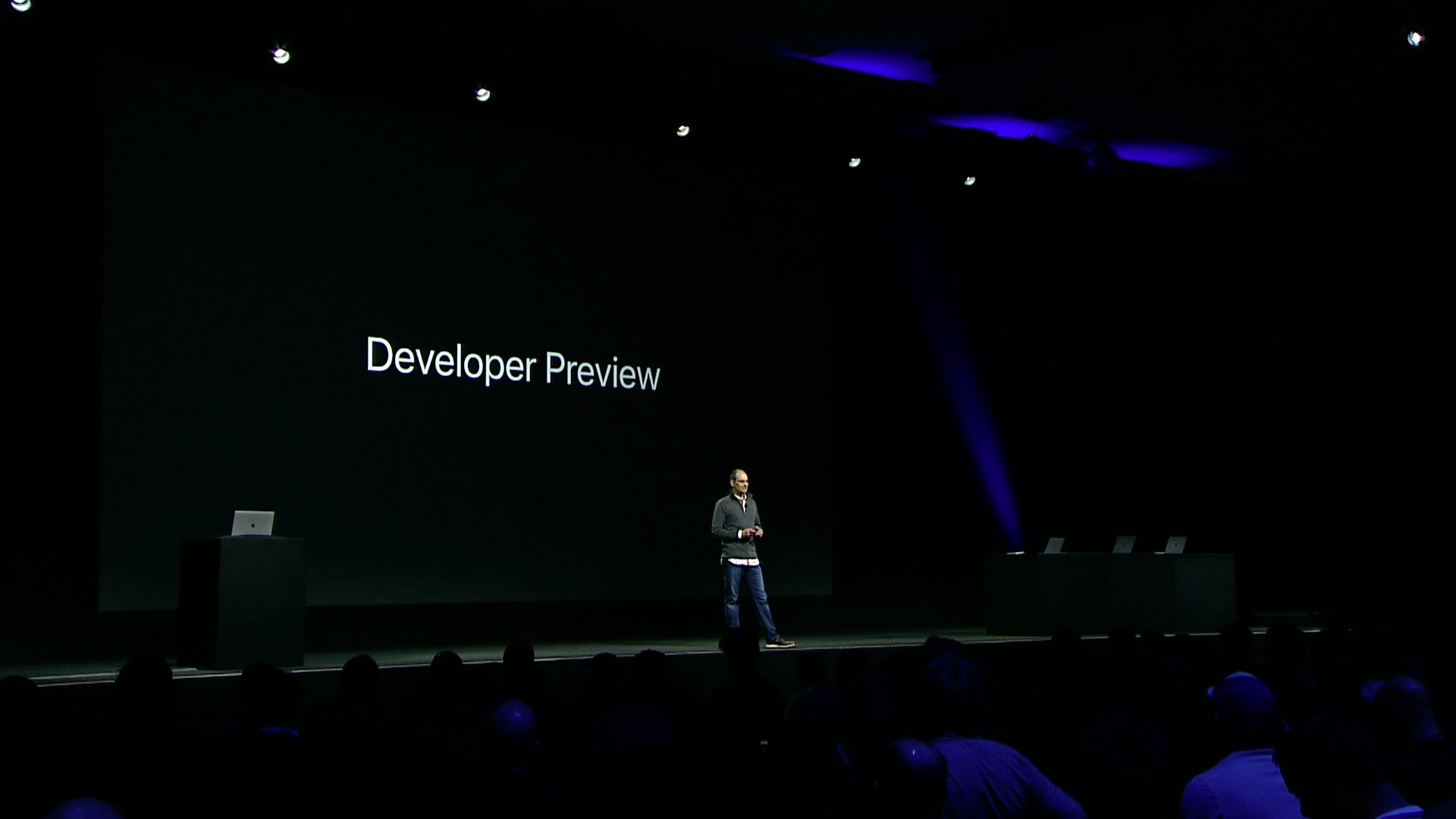
Fast Forward: How Brands Can Start Preparing For Apple’s Business Chat
Editor’s Note: This is an abridged version of our actionable intelligence products. For the full version, please contact our Director of Strategy Adam Simon ([email protected]) to join our newsletter subscription.
What Apple Shared
During a developer session on Friday afternoon, Apple shared some more details about Business Chat, an upcoming feature in iOS 11 that will allow businesses to communicate with customers via Messages, the default messaging app on Apple devices. We briefly mentioned this feature in our in-depth analysis of this year’s WWDC event, but this session provided us with a full set of feature specifications and a roadmap for brands to prepare for the public roll-out of Business Chat, which will occur sometime next year.
First up, Apple specified that Business Chat will be accessible through a “Message” button placed next to the “Call” button currently shown in the business information card found in Apple Maps, Safari search results, Spotlight search results, and Siri responses. Deep-link URLs linking to a specific Business Chat account will also be available for business to embed “Message” buttons into websites and apps so as to drive conversations.
Apple stressed that customers will have to be the ones to initiate the chat, but once they did, businesses are free to provide updates and send other messages. Business Chat conversations are saved as long-lived sessions, meaning that there will be no need for reintroductions and re-briefing when customers re-engage with a business, as they will be identified with an anonymized token ID with all previous chat interactions available for review.
Brands that wish to use Business Chat will need to apply for a Business Chat account and also use a supporting Customer Support Platform (CSP) to help route the inquiries and manage the customer data. According to Apple, there are four CSP services that have already integrated with Business Chat — LivePerson, Salesforce, Nuance and Genesys, meaning that businesses using these CSPs will be able to manage Business Chat using the tools they are already familiar with.
Business Chat also comes with a set of built-in features for businesses to provide a good customer experience. Besides general support for sending texts, images, videos, and documents as users usually can in Messages, it also includes a Time Picker that facilitates setting up appointments (which can also be integrated with EventKit to weed out conflicts with existing calendar events), a List Picker that offers a visual way to present a list of options for customers to choose from, and Apple Pay integration that allows for one-touch payments.
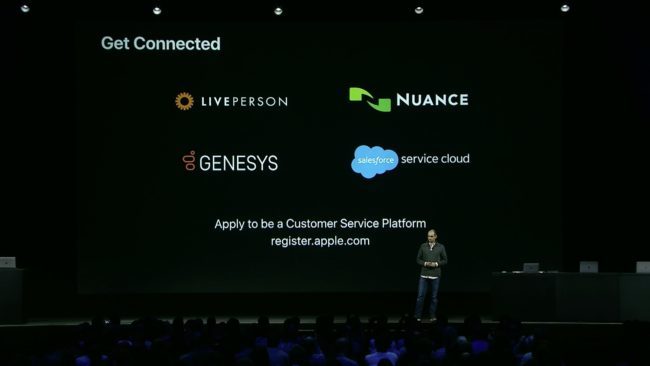
More interestingly, brands can use the iMessage App Framework to integrate iMessage apps into a Business Chat experience to deliver specific services, such as picking out seats in a theater, checking delivery progress, or even playing mini-games. However, Apple made no mention of chatbots, so it remains unclear if there will be a way for brands to automate any interactions within Business Chat.
Why Brands Should Care
The introduction of Business Chat marks an important step for Apple to open its default messaging app to businesses to connect with millions of Apple users, who are spending a significant amount of their mobile screen time in the Message app. According to eMarketer, 34% of all U.S. mobile users are currently using Apple’s Message app, making it the second most popular messaging app in the States after Facebook Messenger.
In fact, one could argue that the main reason that Apple started to add business-friendly features, starting with last year’s introduction of the third-party iMessage app, is to keep up with Facebook and make its messaging platform capable of meeting user’s increasing demand to communicate with businesses. Several studies and surveys have indicated that today’s mobile users would rather text than call. And brands need to be proactively embracing message apps to keep up with the shift in consumer behavior.
What Brands Need To Do
As Apple laid out at the end of the briefing, there are three things that brands can do today to prepare for the official launch of Business Chat:
- Start creating customer support experience with Business Chat SandboxApple release a Business Chat Sandbox tool for businesses and developers to test Business Chat Developer Preview on iOS 11. With it, brands can test out the built-in features they choose to integrate and customize the design elements of their chat experiences. They can also use it to test the JSON payloads before and after implementation. Developers can sign in to Business Chat Sandbox with their iCloud account and start testing.
- Connect with a supporting Customer Service PlatformBecause all user messages for Business Chat are required to be routed through a Customer Service Platform (CSP) after passing through Apple’s own Business Chat server, it is important that brands that are not currently using the four aforementioned CSPs start connecting their support platforms to one of them.
- Apply now for early access to beta testingBrands can now apply for early access to the Business Chat Developer Preview at this webpage, so that when Business Chat enters beta testing, they can be one of the first to start testing it internally with whitelisted employees. This way, once the feature is ready for public rollout, your brand would be ready to jump in on the iOS Message app and reach millions of iOS users, who also happen to be the high-value mobile users.
How We Can Help
The Lab has extensive experience in building Alexa Skills and chatbots to reach consumers on conversational platforms. So much so that we’ve built a dedicated conversational practice called Dialogue. The NiroBot we built in collaboration with Ansible for Kia is a good example of how Dialogue can help brands build a conversational customer experience,
If you’d like to learn more about how to effectively reach consumers on conversational platforms, or to leverage the Lab’s expertise to take on related client opportunities within the IPG Mediabrands, please contact our Director of Strategy Adam Simon ([email protected]) to schedule a visit to the Lab.
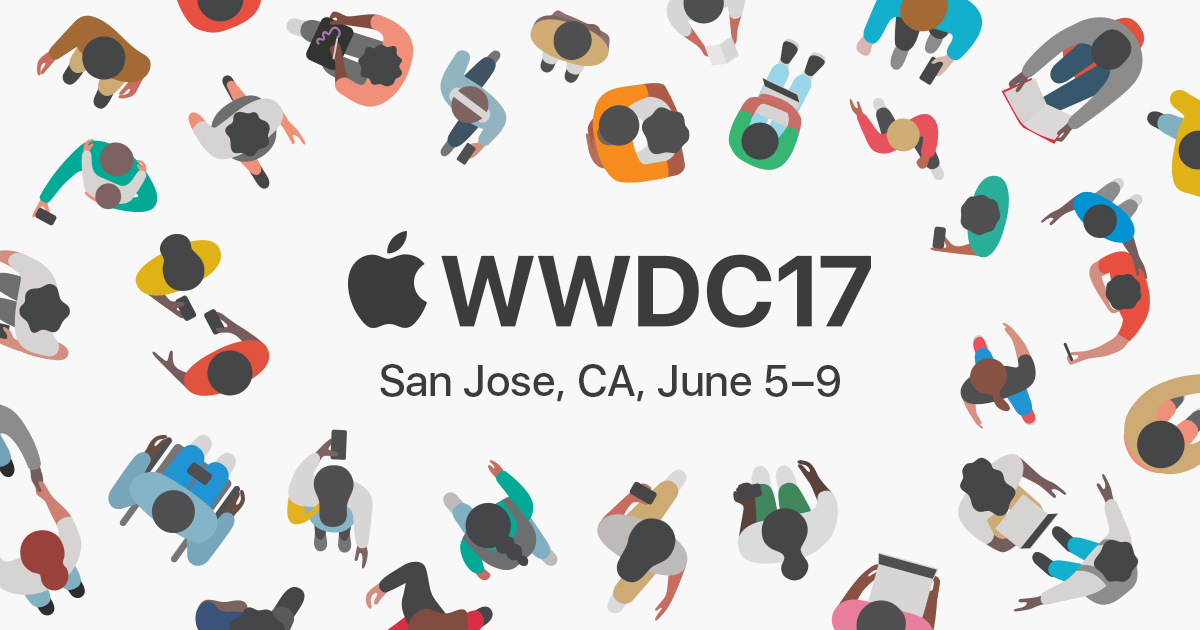
Fast Forward: Everything Brands Need To Know About Apple’s 2017 WWDC
Editor’s Note: As an abridged version of our actionable intelligence products, this post only includes generic suggestions for brand marketers. For the full version, completed with features on our trend-setting partners and industry-specific analysis, please contact our Director of Strategy Adam Simon ([email protected]) to join our newsletter subscription.
The highlights:
-
iOS 11 Brings P2P Payment, Business Chat, Extended NFC Access, & More
-
Apple Launches ARKit, An AR Platform For iOS
-
New macOS Brings VR Creation Support & Better Browsing Experience
-
Siri Rebranded As Apple’s Intelligence Engine, Will Power Upcoming HomePod Speaker
We will be hosting a special briefing call on Thursday, June 8 at 11 a.m. ET to recap this event, what it means for brands, and to answer your questions live. If you’d like to attend, please sign up here.
Apple kicked off its annual worldwide developer conference (WWDC) on Monday at the San Jose convention center. CEO Tim Cook and several other Apple executives took the stage to unveil altogether six big announcements, ranging from new software, new developer tools for VR and AR, a new iPad Pro, and the rumored Siri-powered smart speaker. This event marks Apple’s official entry into the conversational hardware market and offers a glimpse at Apple’s AI strategies moving forward. To delve into the details of the hundreds of new features announced on Monday, check out this round-up on 9to5Mac. What follows is our exclusive take on what these announcements meant for brands and marketers.
iOS 11 Brings P2P Payment, Business Chat, NFC Support, And More
As in years past, Apple previewed the next-gen iOS on stage on Monday. Out of the dozens of redesigns and new features coming to the iPhone and iPad, the ones that we singled out here all bear significant implications for brand marketers.
First up, iOS 11 comes with a revamped Messages app, which will make iMessage Apps more easily discoverable with a swipeable app bar, integration with Apple Pay to support easy peer-to-peer payments, and allow for seamlessly syncing messages across Apple devices with iCloud sign-in. Apple also announced Apple Pay Cash, its own digital debit card that lets recipients of P2P payments transfer the cash to a bank account or spend it at ecommerce sites and physical retail stores.
This new P2P payment feature in iMessage could just be the viral hook that Apple needs to get more iPhone users to adopt Apple Pay. Once users start to use it for paying back family and friends, they would presumably be more likely to try out Apple Pay in retail and other contexts as well. Craig Federighi, Apple’s senior vice president of software engineering, said that half of U.S. retailers will offer Apple Pay by the end of the year.
Apple is also set to introduce a Business Chat feature in iOS 11. While not given any time during the opening keynote, Apple’s developer site indicates that users will be able to chat with a business for customer support and more within Messages. The conversations are started via search in Safari, Maps, Spotlight, and with Siri, and will integrate with Apple Pay (for additional purchases) and Calendar (for appointment scheduling). A clear challenge to Facebook Messenger and Twitter’s customer service use cases, the Lab will be closely watching the session describing functionality and availability of Business Chat this Friday, and will update you once we have more details.
In addition, Apple is expanding its NFC capabilities, allowing developers to access iPhone’s built-in NFC chip for triggering app actions and notifications via a Core NFC framework. However, this function is only viable once the third-party app in question is open, protecting Apple Pay’s privileged position to be opened straight from the lock screen.
While the main camera app will not feature built-in AR functionality in iOS 11, Apple is giving it support for scanning QR codes, which will have the ability to open web pages, or deep-link directly into an installed app using Universal App Links.
Some smaller but noteworthy updates coming in iOS 11 include:
• The App Store is getting a graphic-heavy revamp, breaking games and non-game apps into separate tabs and highlights notable apps with “Editor’s Choices.”
• Apple News is getting support for in-article videos, allowing publishers to get more eyeballs on their video content and, presumably, monetize the attention with ads.
• iOS 11 also bring a significant boost to iPad’s productive use cases with a revamped App Switcher, updated multitasking and file management, and a new “drag-and-drop” feature across apps for the new iPad Pro models.
• Indoor mapping is coming to Apple Maps, allowing it to provide on-premise navigation and in-venue search for select malls and airports around the world.
A developer preview of iOS 11 is available to iOS developers starting Monday, with a public beta set to roll out later this month. iOS 11 will become available to all users as a free software update this fall, presumably with the launch of this year’s new iPhones.
Apple Launches ARKit, The Designated AR Platform For iOS
Apple is catching up with the rapid AR development by launching ARKit, allowing app developers to bring advanced augmented reality capabilities to their iOS apps, including facial recognition, simultaneous localization and mapping (SLAM), and ambient lighting estimation.
During the ARKit demo, Apple showcased easily placing 3D virtual objects on a tabletop, an improved version of Pokemon Go, and an explosion-filled AR video game created by Wingnut AR. The debut of ARKit shows Apple is determined to keep up with its main competitors, namely Google with its Tango AR platform and the newly announced Google Lens feature, and also Facebook with its upcoming Camera Effects platform. ARKit will run on iPhone 6S and later, as well as first-gen iPad Pro and later.
Although the ARKit won’t include tools for object recognition out of the box, it does support importing a third-party library for recognizing objects. This means that even though Apple is coming up short on object recognition in AR for now, developers can roll their own object-recognizing AR features with some outside help and integrate it easily into their iOS apps.
New macOS Brings VR Support & Better Browsing Experience
On the PC front, Apple unveiled the new macOS named High Sierra, which mostly polishes last year’s macOS Sierra and improves performances with updates to core macOS apps like Photos and Mail.
One significant addition that High Sierra brings to Mac users is support for VR content creation. Long absent from the VR landscape, Apple has updated its graphic frameworks to support popular VR platforms from Valve, Unity, and Unreal, allowing developers to create cross-platform VR experience on Mac devices for the first time. On the consumer front, Apple also announced that it has partnered with Valve to bring SteamVR and HTC Vive support to the Mac, starting Monday in beta. The Vive and the developer tools will support the latest iMacs, released Monday, as well as recent MacBook Pros utilizing an external graphics card solution. In addition, a new tier of desktop computers, the iMac Pro, will ship this December with workstation-class performance for the most demanding VR developers.
High Sierra also included several updates to its built-in Safari browser which will impact publishers and advertisers. The new Safari will block autoplay videos from playing on sites that are not dedicated video sites such as YouTube, prevent some ad tracking by using machine learning to segregate the cross-site trackers, and offer an always-on reader mode that users can activate to strip out the non-essential content on web pages. Altogether, these upgrades will make the new Safari “80% faster than Chrome” on a macOS device, offering laptop and desktop users a superior browsing experience while minimizing disruptive ads.
This move mirrors Google’s announcement last week that it will start adding an ad-blocker in Chrome starting early 2018 that will filter out ads that are deemed “annoying” by the standards of Coalition for Better Ads. Together, Safari (10%) and Chrome (51%) make up most of the desktop search market in the U.S., according to comScore, and over 68% of mobile traffic in the U.S. With both popular browsers cracking down on “bad ads” with preinstalled ad-filters, it is imperative that brands and publishers take measures to ensure the visibility of their ads.
Siri Rebranded As Apple’s Intelligence Engine, Will Power HomePod
One of the more subtle yet significant changes Apple announced during Monday’s opening keynote was a rebranding of Siri’s role in Apple’s ecosystem. No longer a mere voice assistant, Siri Intelligence is now the A.I. engine that powers most of the personalization and optimization features in Apple’s apps and service. Whether it’s the personalized recommendations in Apple News or the new predictive watch face layout on the new watchOS 4, Siri has become Apple’s consumer-facing Intelligence service.
Apple bragged about Siri’s natural language capabilities and alluded to a limited number of new “intents” that can be leveraged by third-party apps. Siri is also getting some handy translation skills, allowing English speakers to ask Siri to translate a sentence into several other languages including Chinese, German, Italian, Spanish, and French at launch.
Siri will also be what powers the new HomePod, Apple’s first entry into the smart speaker market. To differentiate it from the existing smart speakers such as Amazon Echo and Google Home, Apple is positioning the HomePod as a high-end wireless speaker designed for music lovers, stressing how its eight independent tweakers and spatial awareness make for a superior acoustic experience.
As opposed to Amazon’s cloud-based approach to AI processing, Apple has chosen to keep its AI services on devices, which improves user privacy but could limit Siri’s capabilities. With voice-based smart devices approaching the mainstream, Apple will need to make Siri significantly smarter and more capable in order to make the HomePod a viable competitor to the Echo, which currently commands over 70% of the U.S. voice-controlled smart speaker market. It seems that Apple knows this, as Apple’s positioning reflects that, focusing HomePod more at the high-end Sonos platform than the lower-priced Echo and Google Home.
More significantly, Apple is getting ready to unleash the full force of machine learning to iOS apps with the debut of CoreML. Utilized across a number of Apple products, including Siri, Camera, and QuickType, and available for developers to deploy within their own apps, this framework promises lightning fast performance with easy integration of machine learning models, allowing iOS apps to add a variety of intelligent features with just a few lines of code. Apple does offer sample models for use with their machine learning libraries, including three different models that can each recognize 1000 types of objects: Notably, it supports the Keras format, which is native to the Google-owned TensorFlow AI platform.
For example, the Vision API will allow developers to build applications which use face tracking, object tracking, and barcode detection. This will no doubt go hand in hand with Apple’s AR push, allowing more apps to add Snapchat-like camera effects and other camera-based mobile AR features.
Another important API from the CoreML bundle is the Natural Language API, which allows brands to add natural language processing capability to their apps. The API supports a tokenization method for picking out certain keywords out of free-styled sentences, allowing it to understand user intent correctly regardless of how a user phrases the request. It enables more developers to build conversational interfaces into their apps for an engaging user experience, or simply as an additional support tool for customer support.
What Brands Need To Do
Taken together, Apple’s announcements at this year’s WWDC are more or less about catching up with its competitors such as Google, Amazon, and Facebook, across a variety of domains ranging from AR to VR, from messaging to voice-controlled home devices. Nonetheless, by the virtue of being Apple, these rather “uninnovative” updates nonetheless spell great opportunities for brands to reach millions of iOS users in whole new ways.
In response, brands should consider:
• Leveraging new APIs to add AR and machine learning capabilities to branded apps & design mobile activations/campaigns.
• Figuring out how to integrate with Business Chat to bring customer support and brand presence to Message, the default messaging platform for millions of iOS users.
• Improving online ad experiences and explore newer, unblockable ad formats, such as in-feed videos, branded content, and sponsored selfie lenses. Tests the site experience with Reader mode on.
(For more detailed brand suggestions, each tailored to your industry, please reach out to join our mailing list for Fast Forward.)
How We Can Help
While mobile AR, VR, and machine learning are all still in early stages of development, brands can greatly benefit by starting to develop strategies for these two emerging areas. If you’re not sure where to start, the Lab is here to help.
The Lab has always been fascinated by the enormous potential of AR and its ability to transform our physical world. We’re excited that Apple is bringing AR features to iOS devices as it enables iOS developers to create AR experiences that reach millions of users. Even the addition of a QR code reader in the camera app spells great potential for marketers to take advantage of. If you’d like to discuss more about how your brand can properly harness the power of AR to engage your customers and create extra value, please reach out and get in touch with us.
As for VR, our dedicated team of experts is here to guide marketers through the distribution landscape. We work closely with brands to develop sustainable VR content strategies to promote branded VR and 360 video content across various apps and platforms. With our proprietary technology stack powered by a combination of best-in-class VR partners, we offer customized solutions for distributing and measuring branded VR content that truly enhance brand messaging and contribute to the campaign objectives.
Machine learning is the marketing buzzword of the year, yet very few marketers truly understand how to leverage it to optimize campaigns and business practices. The Lab has been keeping an close eye on the development on machine learning and artificial intelligence, and how brands can apply relevant tools to provide a superior customer experience. And if you’re confused about the distinction between machine learning and artificial intelligence, you should probably get in touch with us.
If you’d like to know how the Lab can help your brand figure out how to tap into these tech trends coming out of Apple’s WWDC this year to supercharge your marketing efforts, please contact our Director of Strategy Adam Simon ([email protected]) to schedule a visit to the Lab.
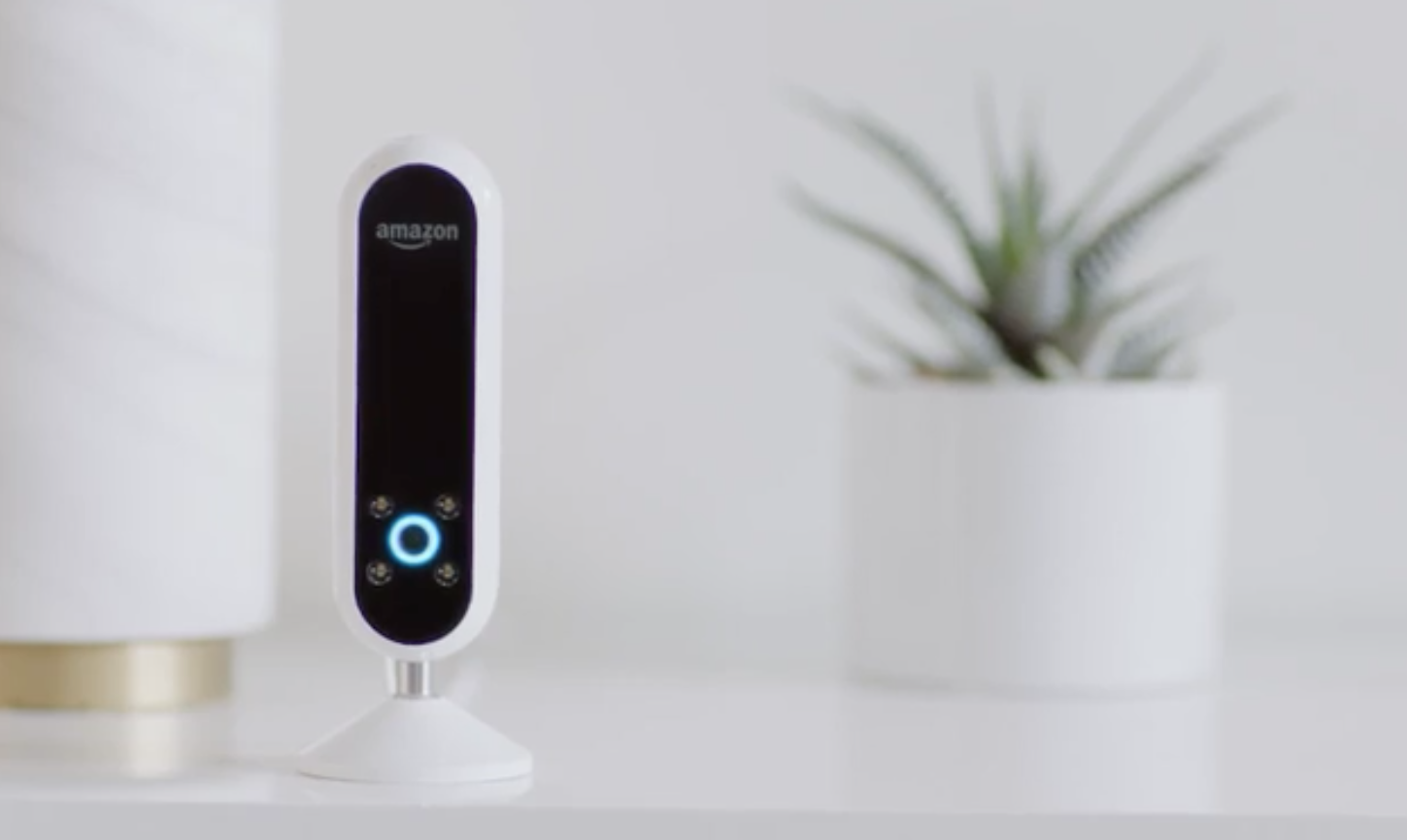
Amazon Adds Computer Vision To Alexa With New Echo Look Device
What Happened
On Wednesday, Amazon unveiled a new Echo device, and it is a big departure from the smart speakers introduced in the Echo lineup so far. Named Echo Look, the newest hardware product from Amazon looks more like a desktop security camera than a connected speaker. But Amazon is actually positioning the device as a hand-free selfie camera and style assistant that can help you take selfies hands-free. Equipped with built-in LED lighting and a computer vision-based background blur feature, it promised to capture the best full-length pictures and videos of you in different outfits for review, comparisons, and style recommendations.
Echo Look comes with a companion app that has a Style Check feature to compare two outfits and rate which is better based on machine learning algorithms. The feature was first added to the iOS Amazon app last month as Outfit Compare and does not require an Echo Look to work. And because it is powered by Alexa, you can ask Echo Look to read you news, play music, or access any of the over ten thousands third-party Alexa skills, just like you would with all the other Echo speakers. This product is available by invitation only for now, and Amazon did not announce it will become widely available.
What Brands Need To Do
By introducing computer vision into the Echo lineup, Amazon is making a strong push to enhance Alexa’s capabilities. Positioning this new device as a “hands-free camera and style assistant,” as Amazon’s product page reads, is a strong reformation of Amazon’s ambition in conquering the fashion industry. Echo Look will help Amazon gain access to millions of its customer’s wardrobes, thus allowing it to glean a huge amount of data from the user-generated pictures to gain great insights on what its customers like to wear and would most likely buy.
Besides, it seems safe to assume that this is merely the first step in Alexa’s evolution. By adding cameras to Alexa-powered devices, the voice assistant now has “eyes” and no longer has to solely rely on voice command for input. Using camera as an input source and combined with machine learning and object recognition, Alexa will grow much more powerful in time.
Wait until Amazon start allowing developers using Alexa Voice Service (AVS) to incorporate visual input into their Alexa-powered products, the new kind of smart home devices will become available as a result present an exciting opportunity that brands will be able to leverage to engage with customers. For example, when a smart fridge can see that you’re about to run out of milk and triggers Alexa to remind you that, it would mean that CPG brands and food retailers will have to rethink their marketing strategies and product design to accommodate this type of conversational smart home devices and new shopper behaviors they engender.
If you’d like to learn more about how to effectively reach consumers on conversational interfaces, or to leverage the Lab’s expertise to take on related client opportunities within the IPG Mediabrands, please contact our Client Services Director Samantha Barrett ([email protected]) to schedule a visit to the Lab.
Source: Amazon
Images courtesy of Amazon’s product demo video

Fast Forward: South By Southwest 2017 Trend Recap
Editor’s Note: As a general version of our actionable intelligence products, this version only includes generic suggestions for brands. For industry-specific versions, please contact our Client Services Director Samantha Holland ([email protected]).
- New use cases for conversational UIs broaden the design of brand experiences
- Artificial intelligence in training for the spotlight and may guide behavioral changes
- New VR and AR demos heralds the next level of immersive and reality-bending experiences
- A display of global culture and communities reflect the open nature of new media channels
Last Friday, the Lab team descended upon Austin, Texas to attend the annual South by Southwest (SXSW) Interactive festival. Over the course of five days, we met with clients and promising startups, chatted with industry insiders and thought leaders, and checked out some innovative exhibitions that companies set up all over town. This year’s SXSW may not have a breakout new trend or app, as Twitter once was in 2007 and Meerkat in 2015, nevertheless, it underscored some of the ongoing trends in consumer technology and marketing with a few new spins that all brands need to look out for.
Conversational Interfaces Test New Narratives
Led by the explosion of interest in voice-based digital assistants, conversational interfaces are having a moment, underscored by Alexa’s take over of this year’s CES. SXSW was no different, as many exhibitors, such as meal replacement maker Soylent and China’s Mobvoi proudly showed off their latest conversational products and integrations. However, we also saw some new products that have the potential to expand the design and narratives of conversational experiences.
For example, Capital One, a “super sponsor” of the festival, brought their newly launched SMS bot Eno to SXSW to showcase the future of conversational banking. Capable of natural language processing, the Eno bot can help customers handle basic tasks such as checking for balances or making payments via text. It can even understand emojis and allow you to send a “thumb up” or “smiley face” as confirmations. Eno is also notably designed to be gender-neutral, bucking the ongoing trend of predominantly female personas among popular digital assistants. When asked if it is a boy or a girl, the bot will wryly reply that it is “binary.”
More innovatively, perhaps, startup Novel Effects brought a new idea to voice-based conversational products, as the founders demonstrated at the SXSW Accelerator pitch event. Instead of making a device that simply reads the bedtime stories for your kids, its product aims to enhance your own story-telling, using voice recognition to listen for certain keywords in the pre-vetted kid’s books and play sound effects and musical cues at the right moments. The experience that Novel Effects envisions is less about back-and-forth conversations, but rather using natural language processing to support storytelling, amplifying the message with environmental and contextual audio cues.
Training AI & Using It To Guide Behaviors
No tech or marketing event in 2017 would be without the buzz surrounding artificial intelligence, and SXSW was no exception. Behind the intensive discussions on its potential applications and ethical issues, the core message is clear – we are on the verge of another industrial revolution led by the deployment of AI-powered robots and services, and everyone, from brands to agencies to media owners, needs to get ready for it. Personal data abound thanks to the increasing adoption of wearables and other connected devices, and by plugging them into AI engines for insights and recommendations, brands may be able to unlock the abilities to guide behavioral changes.
Various keynote presentations and panels this year are AI-themed, including “AI: How Tech’s Next Revolution Will Change Lives” where Diane Bryant, executive vice president of Intel’s Data Center Group, shared her vision for AI innovations, and “Using AI & Machine Learning to Extend the Disney Magic,” where a panel of Disney executives talked about how to apply AI and machine learning tools to storytelling and animations.
In terms of exhibitors, IBM had a big showing by renting out the entire Brazos Hall for four days to demonstrate the various use cases of its cognitive computing service Watson. Guests at the “Makers’ Garage” could use Watson’s cognitive capabilities to design a T-shirt, remix a song, or even create a bot. One particularly interesting activation used Watson to recommend beers based on that participant’s answers to four generic questions that help to discern individual tastes and preferences. Participants were then encouraged to taste the three choices that Watson presents and offer feedback on whether Watson chose the right beers. The goal, IBM says, is to train AI to ask the right questions and improve the accuracy of its recommendations.
Beyond using the SXSW crowd for AI training and educating the event-goers about the revolutionary potential of AI, we also saw an exciting implication that AI could bring to marketing. Bento is a connected device maker that makes sleep monitors for babies and parents, which come with a built-in algorithm that can recommend the optimal nap and sleep time for babies based on their sleep patterns so that the parents can get some rests as well. The potential of the increasing amount of personal data has quantified our sense of “selfhood”, and AI solutions will help people make sense of that data, extract actionable insights, and help guide them to form new habits and make better choices.
Setting The Next Stage For VR & AR
Virtual reality and augmented reality are prominently featured at this year’s festivals as expected. Though nothing groundbreaking was announced, the immersive activations nevertheless demonstrated the advances VR and AR technologies has made in setting the stage for a more socially connected and interactive user experience.
Sony’s Future Lab division demonstrated a multi-person VR game of tag called Superception that allows up to four players to share their perspectives with each other in real time. Built with a network of interconnected VR headsets, the game is to figure out where the other players may be by analyzing all four perspectives.
Viacom’s R&D unit Viacom Next debuted “The Melody of Dust,” a VR experience that is in equal parts VR gaming and interactive composition. Working with the sounds provided by electronica musician Hot Sugar, participants are encouraged to generate their own version of the music video by interacting with different objects in this room-scale VR experience.
On the AR side, advances in facial recognition and tracking have enabled more precise augmented experiences. Philm applies artistically rendered live filters to your photos and videos, whereas AR startup YouCam worked with e.l.f. cosmetics to create a smart mirror that can apply virtual makeup to your face and let you switch between different looks. AR headset maker Meta brought its latest hardware Meta 2 to SXSW, which is positioned as a cheaper yet equally powerful alternative to Microsoft’s HoloLens.
Sony showcased an impressive AR installation with an update of its projector-based touchscreen technology. By combining it with unique user interface design, the new set-up allows users to control holographic objects with their hand gestures. While this may not be ready for the consumer market any time soon, it nevertheless points to a future where mixed reality technology blurs the line between the physical and the digital without the need for a headset or a screen.
Global Culture On DIsplay
SXSW may bear the name of a regional event, but make no mistake, this event is nothing but a globally inclusive display of culture and technological advances. There were more than a dozen of panels and events that showcased the global point of view on tech and creativity.
At the New Dutch Wave house, Dutch media company Talpa reflected on the success and learnings from building The Voice from one hit reality show in Holland into a global phenomenon. By working with local production companies that licensed the show’s format, Talpa was able to tweak the show to fit with the regional realities while maintaining its core elements that transcends cultural differences. The public voting system, for example, has to be altered at times due to smartphone adoption rate in certain global markets, but the chair-turning blind auditions stay consistently the same.
The open nature of the internet has made it possible for content platforms to reach customers across national borders, and the proliferation of smartphones has granted internet access for more customers than broadband ever did. These new digital mega channels, many of which were present at SXSW such as Twitch or Spotify, reflect an increasingly globally homogenizing consumer culture and interconnected communities.
What Brands Need To Do
For brands, the main challenge prompted by the ongoing trends which SXSW underscored comes down to two big questions: how are you designing the user experience, and how do you make use of the customer data?
Whether it’s conversational interfaces or immersive interfaces powered by VR/AR technology, brands have new ways to design their user experiences. The rise of voice-activated home assistants has opened up a new channel for brands to design audio-based experiences to reach customers, and offer a hands-free user experience that is preferable in certain contexts such as driving or cooking.
The new activations and demos from SXSW point to a bright future where VR and AR technology are interactive enough to allow customizable content that offers customers options and social enough to allow the immersive experience to be scalable. As the hardware continues to develop, VR content is quickly emerging as a medium that brand marketers should explore to attract consumer attention with innovative storytelling, whereas AR is positioned to have even bigger implications for marketers by blending digital elements into the physical world.
Besides the obvious opportunities, brands should also consider building audio-based and immersive experiences to augment and support existing marketing efforts. For example, an auto brand may consider developing a voice-based digital assistant for dealerships that can chime in to provide statistics and funny one-liners to support the sales pitch. A retailer, on the other hand, may find it useful to develop a seasonal interactive VR experience to help draw people into stores during holiday sales events.
Beyond designing new user experiences, brands also need to learn to leverage the power of AI to harvest the huge potentials hidden in their customer data. Many companies have launched branded chatbots to reach customers on messaging apps, and they will only get smarter and more helpful as AI technology advances. But few has yet to plug AI into their CRM systems and marketing creatives to deliver personalized user experiences that enhance your brand messages, as well as data-driven, dynamic recommendations that can help modify customer behaviors.
AI is a key driver in the development of autonomous vehicles. But beyond that impending auto revolution, AI can be used to analyze purchase patterns and market trends so as to help brands across industries identify the key moments in consumer journey and reach them with personalized messages. If your brand has yet to consider the potential of AI solutions in transforming your business and marketing practices, now would be the time to start.
How We Can Help
While some of the trends we dived into here are still in early stages of development, areas such as conversation interfaces and VR content are ripe for in-market brand activations. If you’re not sure where to start, the Lab is at your service.
We have extensive experience in building Alexa Skills and AI-powered chatbots to reach consumers on conversational interfaces. The “Miller Time” Alexa Skill we developed with Drizly for Miller Lite is a good example of our expertise. We developed Dialogue, a dedicated conversational practice backed by our stack of best-in-class technology partners and an insights engine that can help you build the optimal conversational experience and extract business intelligence from conversational data.
As for VR, our dedicated team of experts is here to guide marketers through the distribution landscape. We work closely with brands to develop sustainable VR content strategies to promote branded VR and 360 video content across various apps and platforms. With our proprietary technology stack powered by a combination of best-in-class VR partners, we offer customized solutions for distributing and measuring branded VR content that truly enhance brand messaging and contribute to the campaign objectives.
Additionally, if you want to learn more about how to employ AI beyond conversational interfaces and how to effectively reach a global audience via new online channels, we have more strategic insights on these topics that we are happy to share and customize for your brand as well.
If you’d like to know how the Lab can help your brand figure out how to tap into these tech trends manifested at SXSW to supercharge your brand with digital solutions, please contact our Client Services Director Samantha Holland ([email protected]) to schedule a visit to the Lab.

SXSW 2017: All The Cool Stuff That You Missed Over The Weekend
As with years past, the Lab team descended upon Austin, TX on Friday for the annual media, art, and tech bonanza that is South by Southwest. Over the weekend, we have been busy meeting with promising startups, industry thought-leaders, and clients, but we have also taken some time to check out what’s on exhibition this week. Here is a roundup of some of the coolest innovations coming out of SXSW that you missed over the weekend.
As with last year, VR experiences are everywhere at this year’s SXSW. One that stands out from the pack is the “Zero Gravity VR Experience” that Universal set up to promote its The Mummy reboot. Working with Positron, a startup that specializes in making motion-simulating VR chairs, the movie studio created a powerful VR experience that adds a new immersive dimension to the actions. While most branded VR initiatives still rarely dare to move beyond simple 360-degree videos, VR experiences like this one point to some exciting direction that immersive media content could be headed for.
Chinese electric car brand NIO debuted its new NIO EVE autonomous EV concept car, which is equipped with an “artificial intelligence engine” called NOMI for the passengers to interact with the vehicle. The company noted that it plans to bring the car to the U.S. market by 2020. As self-driving vehicles continue to develop, we are excited to see how that will the transform future of transportation and supercharge the auto industry.
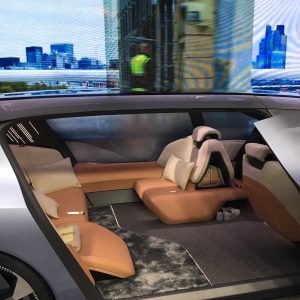
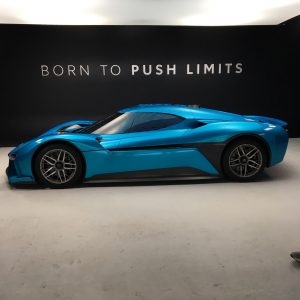
Levi’s announced at the SXSW that the smart jacket it is collaborating on with Google on now has a release date and a price tag. The connected jacket uses conductive fabric to turn a jacket into a connected remote that can communicate with your smartphone and send commands, such as tapping your sleeves to pause a song. Levis says it will be available this fall and will set you back around $350 a piece.
https://www.youtube.com/watch?v=yJ-lcdMfziw
Sony brought back its projector-based touchscreen technology to SXSW this year and combined it with some unique user interface design to allow users to control AR objects by gesture. The company’s Future Lab program is also showcasing some of its latest hardware concepts at a so-called “Wow Factory” in a converted warehouse. As digital interfaces continue to evolve, brands need to catch up and update the UX design of their online touch points accordingly to deliver a fresh, fun, and functional customer experience.
Adidas says it is looking to collaborate with third-party brands to create a new open ecosystem for its digital fitness products. The company acquired fitness tech company Runtastic in 2015 to boost its fitness tech efforts, but it has lagged behind competitors such as Nike and Under Armour in building out a digital fitness community. This announcement comes just one month after the company’s decision to shut down its MiCoach platform in favor of consolidating that ecosystem with Runtastic’s, and indicates Addidas’ plan for building out its digital fitness offerings.
Check back for more SXSW updates as the festivals go on this week.
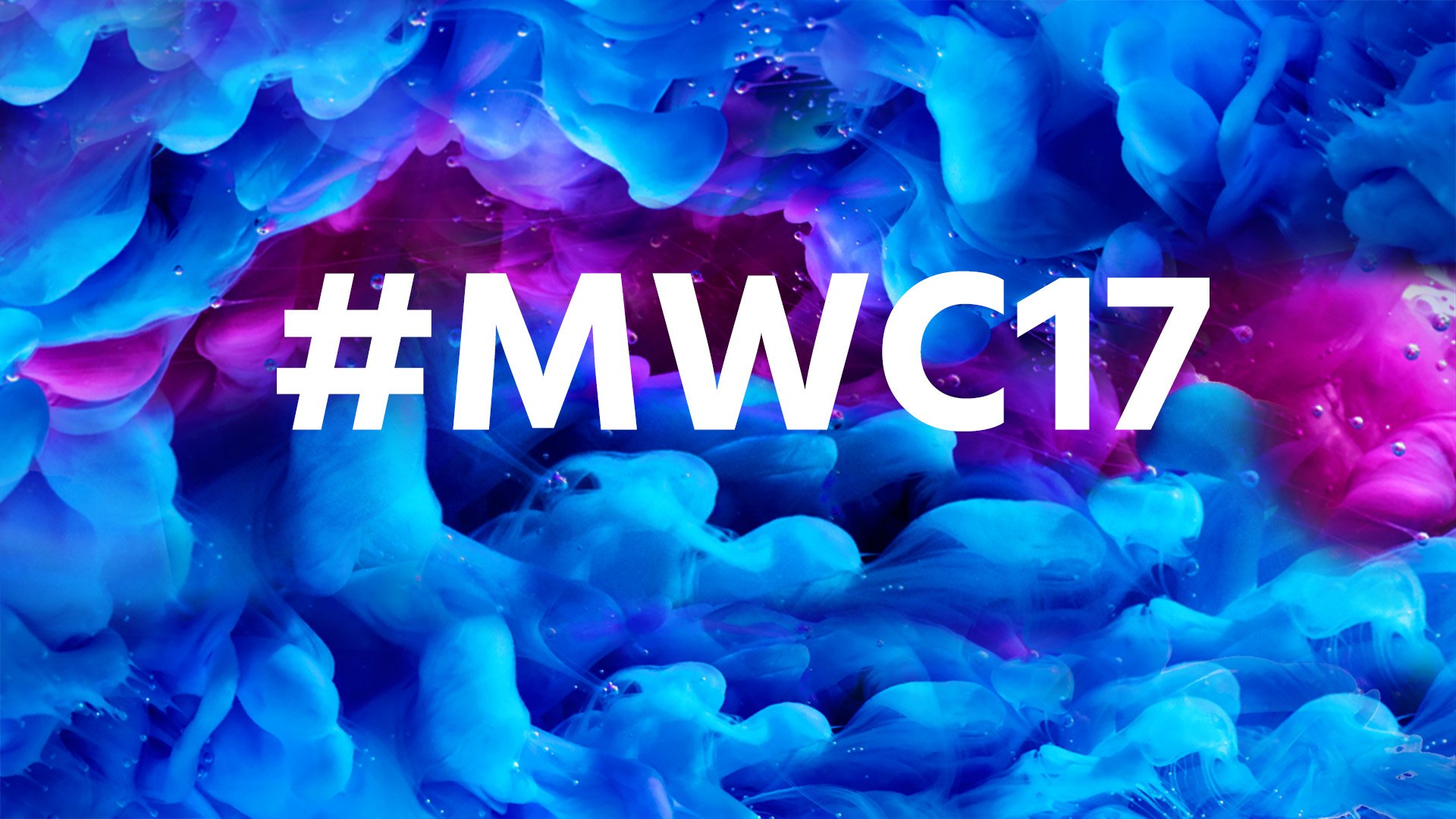
Fast Forward: Mobile World Congress 2017 Trend Recap
Editor’s Note: As with all Fast Forward analysis, this recap first went out to our subscribers via newsletter one day prior to its posting on this site. We also customized our recap to offer tailored CES insights for brands in eight verticals including auto, CPG, retail, travel, and more. For inquiries about joining our subscription list, please contact our Client Services Director Samantha Holland ([email protected]).
The highlights:
- Mobile industry starts to move beyond smartphone, looking to explore 5G-powered IoT devices as the next growth area
- Artificial intelligence sets to bring new dimensions to UX design and power innovative customer solutions
- Virtual reality had a strong showing, beginning to mature as an interactive, experiential marketing tool
Last week, the Lab team crossed the Atlantic to attend the 2017 Mobile World Congress (MWC) in Barcelona, Spain. We were joined by our friends at Ansible, who launched the MDEX, a global index for assessing brand performance and mobile readiness, with a keynote address from Global President Travis Johnson. Together, we scouted the exhibition floors, attended keynote events, and met with industry leaders, innovative startups, and clients. In addition to our daily updates on the big announcements, the Lab is now proud to present this final recap on the most important trends we saw at this year’s event.
For the last few years, we have seen a steady expansion of the common topics at MWC, which started as a trade show for the mobile industry but has since grown to cover a variety of adjacent domains within the digital economy. This trend is particularly pronounced this time around, with talks of 5G, IoT, and Artificial Intelligence dominating the event. As the industry begins to branch out of building the next flashy smartphone to figure out what might be “The Next Element,” the event theme of this year, it sends marketers a harbinger of the changes to come.
5G Is The Near Future
5G has been a topic of discussion at MWC in the years past, albeit mostly as a future aspiration for the industry. But this year, the industry is abuzz with key players pushing for the next-level cellular wireless connectivity with actual products and initiatives.
Samsung hosted a 5G-heavy press conference on Sunday to announce a long list of new devices and IoT efforts that will support 5G. On Monday, Ericsson announced a collaboration on 5G trials with Qualcomm and NTT DOCOMO in Japan, as well as a partnership with Qualcomm to develop a new 5G radio for Vodafone. Cisco announced a partnership with Verizon that aims to help bring 5G connectivity to the enterprise market. Manufacturers such as ZTE, Nokia, and Intel all prominently featured 5G innovations in their press events and exhibitions.
What Brands Need To Do
Despite all the buzz around 5G, the reality remains that it is still at least 2 to 3 years away from deployment at scale. Speeding up cellular connectivity will not fundamentally alter consumer behaviors, although it will help brands to deliver more sophisticated creative in data-heavy formats, such as HD 360-degree video, to mobile users.
The real opportunity for brands that 5G brings lies in the vast number of IoT devices it will enable with a faster and more robust network. There will be over 24 billion connected devices is use by 2020, according to the estimation of BI Intelligence. From connected vehicles to home automation, 5G is set to unleash an unprecedented level of always-on connectivity to more and transform cars and home appliances into an extension of the digital media landscape. This will no doubt open up new channels for brands to reach their customers and gather valuable data.
For example, auto brands might consider integrating 5G connectivity into its infotainment systems to deliver a more reliable digital dashboard experience, whereas a retailer may start implementing 5G-enable IoT networks to power new in-store experiences.
The Rise Of AI-Powered Solutions
Besides the buzz around 5G, another hot topic at this year’s MWC is the quick advances in artificial intelligence and machine learning and how the AI-powered solutions will supercharge brand-customer interactions via the interfaces and personalization tools. And there’s a lot of vendors at the events that are putting AI into good use.
P&G-owned skincare brand Olay made their debut at MWC with the global launch of its AI-powered Skin Advisor platform. Available via Olay’s mini-site, the web-based skin analytics platform leverages artificial intelligence and deep learning to provide skin analysis and personalized product recommendations delivered right on their mobile phones or tablets.
Japan’s leading chat app Line announced Clova, an Alexa-like voice assistant it created with Naver, to bring AI-powered conversational services to the Asian markets. In addition, Line is working with the several companies including Sony and LG to integrate Clova into more consumer gadgets and connected devices.
It’s also telling how some brand executives at the event expressed their interests in AI-solutions. A Coca-Cola executive said the company is interested in using artificial intelligence to improve content, media, and commerce, especially in streamlining the ad creation process and experimenting with automated narratives. In his keynote session, Netflix CEO Reed Hastings revealed that the company is using an AI engine to tweak its video content to make them look good even over slow internet connection. He even jokingly suggested that in 50 years Netflix’s primary customers might be AI robots rather than humans.
What Brands Need To Do
For all the talks of innovations, the mobile tech world is also realizing that it needs to focus more on making the user experience as simple and seamless as possible to drive adoption and, in turn, more innovations. While a younger consumer may have little trouble in adopting the newest digital tools, such as mobile banking app, the older generations will likely need to be guided by a more intuitive and user-friendly UX design to get on board. In this regard, AI-powered solutions, such as voice-based conversational interfaces and personalized recommendations, are the key differentiators in building a more intuitive and frictionless customer experience for all.
The rapid advances in AI and machine learning have the potential to fundamentally change brand-customer relationships and significantly increase customer expectations, especially in regards to customization and user experiences. Smarter chatbots and other AI-powered conversational services will allow brands to engage with even the most non-tech-savvy consumers. The majority of customer service will soon become automated, so there’s no more excuse for latency in replies. In addition, brands also need to figure out how they can leverage their customer data to provide customers personalized experiences with the help of an AI engine.
To more effectively reach customers, for example, CPG brands will need to apply AI to analyze customer data for purchase trends in order to create personalized product recommendations and contextual value offers. For healthcare and fitness brands, AI-powered solutions can be used to analyze health or workout data for behavioral insights in order to deliver personalized health or exercise recommendations.
Virtual Reality Gets More Interactive
Despite the lack of VR-ready smartphones announced at this year’s MWC, virtual reality still had a strong showing as the technology continues to mature. Samsung unveiled the redesigned Gear VR headset, which now comes with a handheld controller for easier and more precise navigation and interactions. Previously, Gear VR users had to rely on head-tracking to navigate the VR experiences. Plus, the company is also reported to be secretly showing off standalone VR headsets that can operate without Samsung smartphones.
Similarly, LG also unveiled the VR headset prototype it has been working on with Valve, and the results are pretty much positively close to the HTC Vive – currently the gold standard in VR headset technology – if not better. Like the HTC Vive, the new LG VR headset uses Valve’s Lighthouse tracking technology to let you walk around a room, or uses its two controllers to reach out and grab things in virtual experiences.
Beyond the usual VR players, Korea Telecom offered up one of the more fun and innovative VR experience at the event. The carrier teamed up with K-pop band Twice to create a music video that doubles as a VR roller coaster ride. Attendees are strapped into a hamster-wheel-like device, which tumbled in tandem with the visuals to create an intense, full-body VR experience.
What Brands Need To Do
As virtual reality hardware continues to develop, the simulated experiences will only become more interactive and immersive, which opens up new opportunities for brands looking to engage their audience.
While many brands have dipped their toes into VR content, they often opt for the easier route of creating 360-degree videos viewable in VR headsets. In the past two months alone, we have seen brands like Ford, Häagen-Dazs, and Expedia to do just that. Moving forward, however, that will soon become inadequate, as the lack of interaction severely hampers the sense of immersion. To unlock the full power of VR experience, brands will have to move beyond simple 360-degree videos and work with VR content creators to build more sophisticated virtual experiences.
Retailers, for example, can create fun shopping-themed VR experiences to draw in customers. For entertainment brands, this could mean developing a short interactive VR experience to promote new releases or teaming up with game developers to feature some of your IPs in their works.
How We Can Help
Feeling a bit overwhelmed by all these latest trends in consumer tech? The Lab is here to help. We have extensive experience in building Alexa Skills and AI-powered chatbots to reach consumers on conversational interfaces. So much so that we’ve built a dedicated conversational practice called Dialogue. The “Miller Time” Alexa Skill we developed with Drizly for Miller Lite is a good example of how Dialogue can help brands build a conversational customer experience supercharged by our stack of technology partners with best-in-class solutions and an insights engine that extracts business intelligence from conversational data.
Additionally, if you want to learn more about how to employ AI beyond conversational interfaces or chat some more about the latest sleep tech boom, we have more strategic insights on these topics that we are happy to share and customize for your brand as well.
As for VR, our dedicated team of experts is here to guide marketers through the distribution landscape. We work closely with brands to develop sustainable VR content strategies to promote branded VR and 360 video content across various apps and platforms. With our proprietary technology stack powered by a combination of best-in-class VR partners and backed by the media fire-power of IPG Mediabrands, we offer customized solutions for distributing and measuring branded VR content that truly enhance brand messaging and contribute to the campaign objectives.
If you’d like to know how the Lab can help your brand figure out how to tap into these tech trends from the MWC to supercharge your brand with digital solutions, please contact our Client Services Director Samantha Holland ([email protected]) to schedule a visit to the Lab.
For previous editions of Fast Forward, please visit ipglab.com. Please reply with any constructive criticism or feedback. We want these to be as useful as possible for you and your clients, and your input will help us immensely.
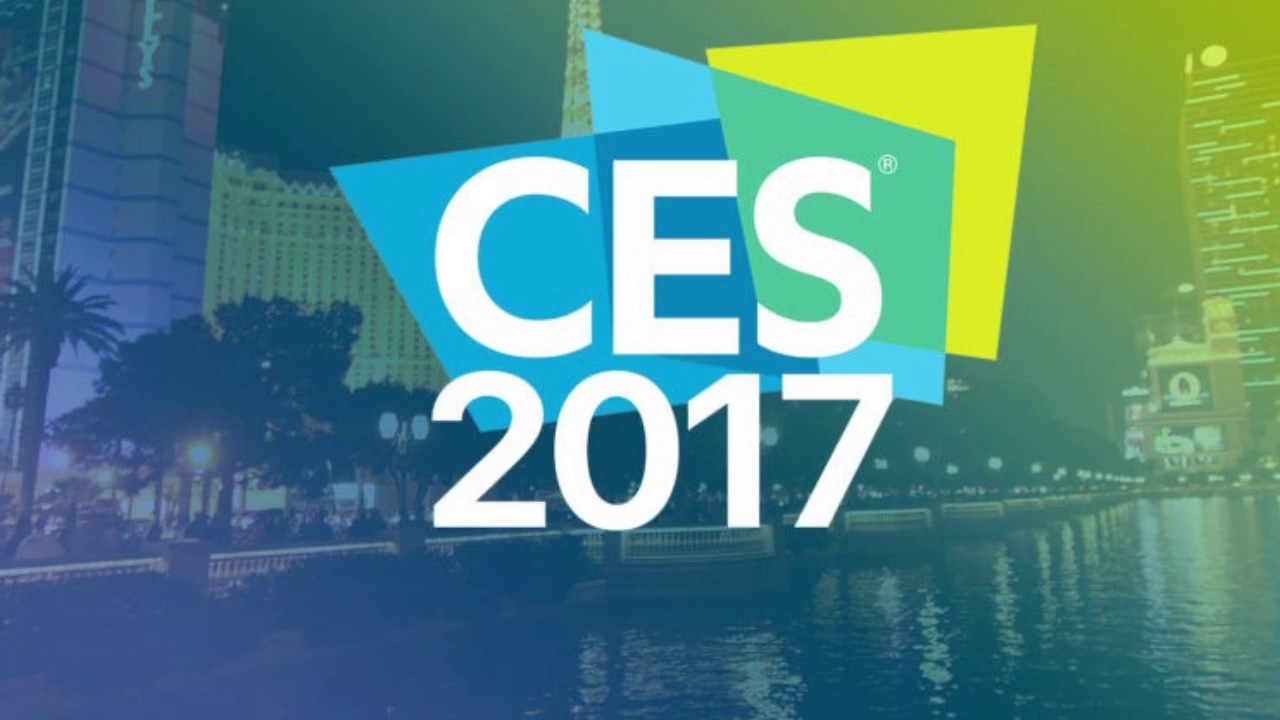
Fast Forward: CES 2017 Recap
Editor’s Note: As with all Fast Forward analysis, this recap first went out to our subscribers via newsletter one day prior to its posting on this site. We also customized our recap to offer tailored CES insights for brands in eight verticals including auto, CPG, retail, travel, and more. For inquiries about joining our subscription list to receive actionable intelligence specifically tailored to your brand’s industry, please contact our Client Services Director Samantha Holland ([email protected]).
This is a special edition of our Fast Forward newsletter, bringing you a summary of the major trends we spotted last week at CES 2017.
The highlights:
• Alexa taking over the smart home, opening a path for brands to enter
• AI-powered solutions ready for market with varying implications
• VR tech continues to mature as AR use cases proliferates
The 50th CES has officially come to an end on Saturday. Throughout the 4-day consumer tech extravaganza, the Lab team scouted the show floors and identified the best and most memorable gadgets on display to show our VIP clients on our guided tours. As with previous years, the industry trends that emerged from the convention centers in Vegas will continue to shape consumer behaviors and expectations in the coming year. Here, we highlight the most important market trends from CES and what your brand can do to take advantage of them.
Alexa Is Taking Over The Smart Home
One of the most obvious and indisputable trend at this year’s CES is how prevalent voice-activated digital assistant services, in particular Amazon’s Alexa, are being integrated into all sorts of connected home gadgets, ranging from washing machines made by Whirlpool to light switches from WeMo, from LG’s Alexa-integrated InstaView fridge to Samsung’s new Roomba competitor.
As many third-party OEMs take advantage of Amazon’s recently introduced Alexa Skills Kit and start eagerly integrating Amazon’s beloved digital assistant service in their products, Amazon, who is not even at CES in any official capacity, is winning a distribution advantage in its battle against rivals like Google Assistant and Microsoft’s Cortana, which announced some high-profile brand integrations of their own. Google Assistant is the service powering NVIDIA’s new connected home product line, while Cortana is coming to connected vehicles developed by Nissan and BMW.
What Brands Need To Do
Judging by what we saw at CES, Amazon is clearly leading the race of voice-activated personal assistants with Alexa and its Echo line-up. The ecommerce giant is estimated to have sold over 9 million Echo devices worldwide over this holiday season, bringing the total number of Echo devices in market to about 14 million. As Alexa can also be integrated into third party products, the total number of Alexa-enabled devices, though, is much higher, and is poised to grow considerably after this week’s announcements.
As Amazon continues to push for Alexa’s integration with other smart home providers, the voice-activated assistant is quickly conquering the home space and bringing AI-powered interfaces to mainstream consumers. It is becoming more evident than ever that voice-based brand-customer interaction is something that brands have to explore and master.
Smart home devices hold great potential for brands because they offer a way in for those brands to reach consumers at home and connect with them in a more intimate, relaxed context. For example, Mattel introduced Aristotle, a connected toy with Alexa integration for kids that also doubles as a shopping tool with which parents can order child care products.
But even brands that won’t embed voice into their own product experiences should still look to capitalize on the opportunity by offering complementary services: recipes, wellness information, and lifestyle content are all popular uses for Alexa, and areas where brands can look to add value.
Amazon has integrated Alexa in its Fire TV service for a while now, and this year at CES, the company is also partnering with Westinghouse and other TV manufacturers to have Fire TV power their sets, therefore bringing Alexa to the living room via voice remote control. In addition, DISH announced it will support Alexa voice control on its Hopper DVR. For brands, this means it is crucial to properly index your branded and sponsored content for voice search so as to ensure a smooth and easy content discovery on streaming devices.
AI-Powered Solutions Set To Revolutionize Industries
Artificial Intelligence is a term that got thrown around a lot at CES, referring to a number of things ranging from cloud-based computing to natural language processing. But at the end of the day, it means software that gets better based on user input, and it is set to transform various industries ranging from healthcare to transportation by enabling new tools such as autonomous drones and industrial IoT network.
This CES has no shortage of new connected devices that incorporate AI in one way or another. From the fast development in autonomous cars to smaller home gadgets like the smart kitchen assistant by Hello Egg, artificial intelligence of varying degrees is being integrated to a wide range of products to enable smart automation and personalization solutions.
Aided by the major advances in AI, the race of developing autonomous cars is particularly palpable at this year’s CES, with major carmakers such as BMW and Hyundai and some tech companies like Harman and NVIDIA showcasing some sort of driverless concept models and announcing plans to accelerate their self-driving car developments.
For brands offering services and experiences, the implementation of AI-powered solutions is set to unleash a new kind of customer experiences that they will need to adapt. The best example of this from CES is the new cruise experience that Carnival unveiled during its keynote presentation. Backed by a whole ship full of proximity sensors and a cloud-based computing system, Carnival allows guests to ditch their IDs, credit cards, and cruise cards for a small connected wearable called the Ocean Medallion for all authentication and payments on board.
What Brands Need To Do
For brand marketers, AI is what will power the future of brand-customer interactions as the core of the post-smartphone computing. In fact, many consumers have already made first contact with AI-powered services in 2016 in the forms of conversational interfaces that include various chatbot services and the aforementioned Alexa. Numerous brands have launched branded chatbots to reach customers on messaging apps, and they will only get smarter and more helpful as AI technology advances.
Another important capability that AI will unleash for all brands lies in dynamic creatives that can deliver personalized user experience based on data and user input. Brand marketers need to consider how they can leverage their customer data to to provide personalized experiences with the help of an AI engine.
One additional implication the AI evolution is set to bring for all brands is the additional media time that self-driving cars will free up once we can take our eyes off the road. While it is still a few years off before the technology fully matures, it is never too early for brands to start thinking about how to conquer this new media space and connect with consumers on the road.
Virtual Reality Matures As Augmented Reality Ramps Up
Besides the prevalence of Alexa, another hard-to-miss trend at this year’s CES is the proliferation of VR and AR products. Although they are sometimes lumped together, what we saw at this year’s CES showed that they are in quite different developmental stages.
Virtual reality has benefited from the fast growth in production tools and content platforms and starts to enter a maturing stage as it enters mainstream consumer market. At CES, Lenovo unveiled a light prototype VR headset that works with Microsoft’s Windows Holographic platform. While HTC didn’t update its Vive VR headset, it did introduce a series of add-ons to enhance its flagship headset, including a peripheral called TPCast that can power a wireless VR experience, as well as a Vive Tracker that can turn any physical object into a VR controller.
As with last year, 360-degree and VR-ready cameras are also getting some updates, making the production of VR content easier and cheaper, with varying degrees of immersion. Ricoh’s new 360-degree camera can live stream for 24 hours, whereas China’s Insta360 created a camera accessory that can clip onto any Android smartphone and turn it into a 360-degree camera.
Augmented reality, on the other hand, is still developing as a mass-market product category, but that didn’t stop a lot of brands to come out with their own AR products. ODG debuted two sleek AR glasses powered by Qualcomm’s new Snapdragon 835 chip. Then there is the HoloLamp, a lamp-shaped projector that brings 3D animated objects to life in the real world with no headset or glasses required. Similarly, Merge VR created a holographic toy called the Holo Cube, which lets users interact with holograms through its headset.
Besides standalone devices, we are also seeing a lot more VR/AR-ready smartphones and PCs at this year’s CES. The ZenFone AR from Asus is the first phone to support both Google’s mobile AR platform Tango and Google’s Daydream VR platform. Asus also debuted a compact VR-ready desktop PC that will retail for just $799. In addition, Lenovo unveiled two new Legion gaming laptops ahead of CES that are VR-ready.
What Brands Need To Do
All these latest products from CES demonstrates that VR and AR technology are quickly advancing and becoming more attainable for mainstream consumers. As the hardware continues to develop, VR and 360-degree content is quickly emerging as a medium that brand marketers should explore to attract consumer attention with innovative storytelling.
With major tech and media companies rushing into VR to capitalize on the booming popularity of the immersive medium, brands should take a cue and start developing VR content that truly enhances brand messaging and contributes to the campaign objectives.
AR, on the other hand, provide some unique use cases for brands across industries. Following the global phenomenon that was Pokémon Go last summer, which introduced AR tech to mainstream consumers, several companies showcased their latest AR initiatives that brands can take some inspiration from.
For example, Intel developed an AR experience using Microsoft’s HoloLens to demo its envisioned autonomous car experience for CES attendees. Gap unveiled an AR app named Dressing Room, which allows mobile shoppers select a virtual mannequin close to their own body type and try on different sizes of Gap items for detailed comparison.
Overall, AR can be a great way for customers to get additional information about your services, to envision your products in their lives. and to launch digital experiences from signage or product packaging. And brands need to start to think about ways for augmented reality to drive new opportunities for your brand.
The Sleep Tech Boom Points To New Area Of Growth
This year at CES, sleep emerged as a hot area for the consumer tech industry, with many companies coming out with their own sleep-related products. As basic activity tracking has become a commoditized part of every wearable and many smartphones, sleep appears to be the next frontier of the quantified self. After all, sleep is an activity that everyone partakes on a daily basis.
Under Armour unveiled a new line of high-tech pajamas designed to enhance sleep quality, as well as some new sleep-tracking features for its branded fitness apps. Sleep Number debuted a connected bed that can self-adjust to fit various sleeping positions throughout the night. ZEEQ smart pillow, which first launched on Kickstarter last summer, also brought their sleep-tracking pillow to the show floor. Then there is the Sleep Dot from Acesleep, a small tracker that you put on your pillow to monitor sleep cycles and body movements. Those are just three highlights among sleep-related products exhibiting at this year’s CES, which even featured its first-ever “Sleep Tech Marketplace.”
What Brands Need To Do
For health and fitness brands, this emerging trend opens up a new product category for them to expand into and benefit from. Integrating sleep data into your brand’s existing digital ecosystem will bring a more comprehensive understanding of your customers and their health habits.
As sleep quickly becomes digitized and emerges as a hot area of interest, however, it will also bring a lot of opportunities that brands in other industries may capitalize on. For example, hospitality brands can partner with companies in this space to equip their rooms with connected sleep products at a low cost. Beauty brands can tap into the idea of “beauty sleep” and incorporate sleep data as part of a branded beauty routine. At CES, both Hyundai and Mercedes-Benz unveiled connected car concept aimed at elevating driver’s mood and wellbeing. It is not too much of a leap to imagine that sleep tech products would be integrated into autonomous cars in the future.
How We Can Help
Feeling a bit overwhelmed by all these new trends in consumer tech? The Lab is here to help. We have extensive experience in building Alexa Skills and AI-powered chatbots to reach consumers on conversational interfaces. So much so that we’ve built a dedicated conversational practice called Dialogue. The NiroBot we built in collaboration with Ansible for Kia is a good example of how Dialogue can help brands build a conversational customer experience supercharged by our stack of technology partners with best-in-class solutions and an insights engine that extracts business intelligence from conversational data.
In terms of immersive content, our dedicated team of experts is here to guide marketers through the distribution landscape. We work closely with brands to develop sustainable VR content strategies to promote branded VR and 360 video content across various apps and platforms. With our proprietary technology stack powered by a combination of best-in-class VR partners and backed by the media fire-power of IPG Mediabrands, we offer customized solutions for distributing and measuring branded VR content that truly enhance brand messaging and contribute to the campaign objectives.
Additionally, if you want to learn more about how to employ AI beyond conversational interfaces or chat some more about the latest sleep tech boom, we have more strategic insights on these topics that we are happy to share and customize for your brand as well.
If you’d like to know how the Lab can help your brand figure out how to tap into these tech trends manifested at CES to supercharge your brand with digital solutions, please contact our Client Services Director Samantha Holland ([email protected]) to schedule a visit to the Lab.

CES 2017 Day 3: Under Armour Joins The Sleep Tech Boom
Earlier this afternoon, Under Armour CEO and founder Kevin Plank delivered the last solo keynote address of this year’s CES. The fast-talking CEO began with a passionate and detailed account of the transition his company has successfully made in recent years from a sportswear brand into a fast-growing athleisure lifestyle brand supercharged by fitness technology, before moving on to introduce a few new products and updates.
The Sleep Tech Boom
As we noted in our CES First Look on Tuesday, sleep-related tech is a hot area at this year’s CES, which even created its first-ever dedicated “sleep tech marketplace.” Startups like Vobot, Motio HW, ZEEQ, and Acesleep come to showcase their products all designed to monitor and enhance your sleep. Sleep Number debuted a self-adjusting connected bed that can fit various sleeping positions and alleviate mild snoring.
Now, Under Armour is jumping on the sleep tech bandwagon with a new line of sleepwear dubbed Athlete Recovery Sleepwear. The company partnered with researchers from John Hopkins University and star quarterback Tom Brady to design this high-tech pajama line, made with a special fabric that the company claims can enhance your sleep quality by absorbing heat and improving blood flow and cell regeneration.
The company announced on stage that it is partnering with Arianna Huffington’s lifestyle and wellness brand Thrive Global to promote this new line of sleepwear. On the software side, the company is also updating its UA Record app to incorporate its new focus on sleep. New features for this fitness tracking app include generating reports on sleeping cycles and consistency and offering tips on how to achieve better sleep.
As sleep quickly becomes digitalized and integrated as part of our health and fitness data, we expect to see more fashion, healthcare, and sports brand to come out with their own sleep-related initiatives.
Under Armor’s Digital Fitness Strategy
Beyond its new sleep initiatives, Under Armour also updated its MapMyRun app to add a feature called Jump Test, which asks users to do a set of jumping jacks and uses the sensors on its connected footwear line to determine if your body has sufficiently warmed up for a run.
Under Armour is not the only company showcasing fitness-oriented connected apparels at this CES. Two standout examples from this category are Polar’s new connected sports shirt, which comes with built-in vital-tracking sensors that can share data in real time, and the “E-Skin” bodysuit developed by Xenoma, which is embedded with 14 motion-capturing sensors designed to track your full-body movements during workouts.
A big part of the success that Under Armour has enjoyed so far can be attributed to its digital fitness strategy. Looking beyond physical products like apparels and shoes, the company made a series of acquisitions from 2013 to 2015 that beefed up its fitness app portfolio, which includes the aforementioned UA Records and MapMyRun as well as the popular calorie-tracking app MyFitnessPal. By allowing its customers to aggregate and understand the fitness data they generate with their apps and products, the company has fostered an online fitness community of over 160 million users. For other fashion and sports brands, this digital-led strategy should provide some inspiration in how to effectively reach and engage with today’s connected consumers.
